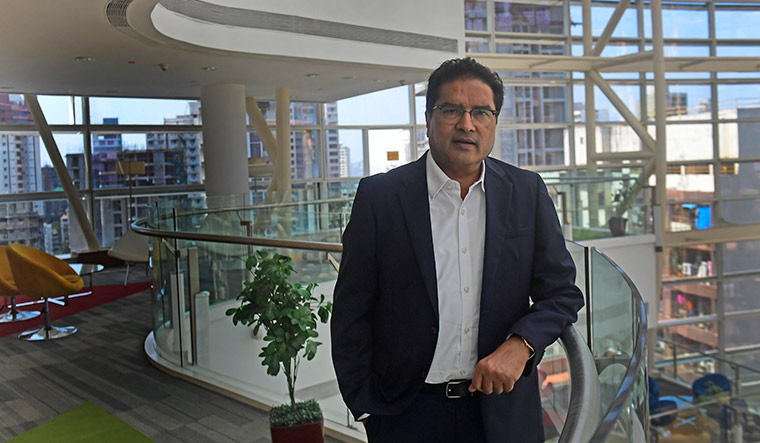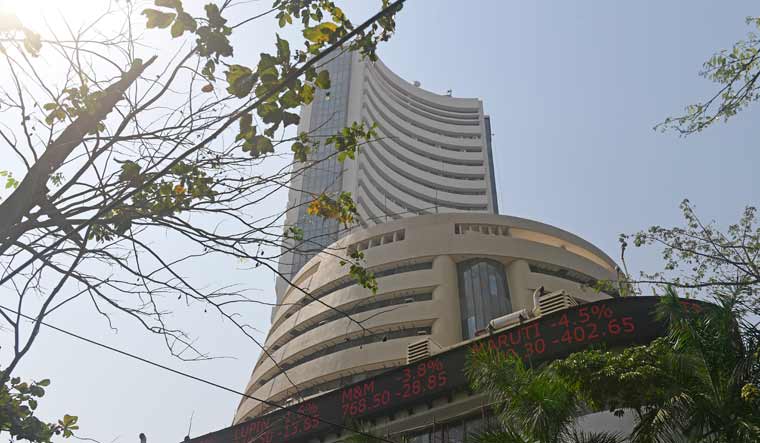India's equity markets have corrected a fair bit over the last eight-nine months; as of Tuesday's close the BSE Sensex was down 12 per cent. There has been some upmove in recent weeks; since the 52-week low of 50,921.22 on June 17 this year, the benchmark has re-scaled 55,000 levels now. However, there is still a lot of volatility and uncertainty surrounding geo-political tensions, inflation and fears of a global recession. In an exclusive interview with THE WEEK, market veteran Raamdeo Agrawal, the chairman and co-founder of Motilal Oswal Financial Services, shares his views on investing in these uncertain times, sectors he is confident on, FII selling among other things.
Q. We have had the pandemic, followed by the Russia-Ukraine war. Inflation has surged worldwide, fuelling recessionary fears. In this backdrop, how do you think equity markets are going to play out after the correction they have already had?
There are three factors. One is corporate earnings, which are the most important. Second is FII (foreign institutional investor) activity. Third is oil and gas price. There are lot of forces, because of which we don’t know where energy prices are going. You have global demand, supply concerns, Russia is among the top producers. If they remove 1-2 million barrels of oil from the market, market can again become very tight. There is demand destruction also. Due to high inflation, the demand will also get curbed to some extent. I want my oil prices to be lower, because I am a net importer. At least it should be in a range, where I can afford to pay and it doesn’t challenge my current account deficit (CAD). So, at about $80 a barrel, the current account will be at some kind of a balance, around 1.0-1.5 per cent, which can be easily funded. The wheels of the economy will move a lot better and this continuous threat to the rupee vis-a-vis dollar will also not be there. We are seeing some contraction in commodity prices, which should provide some relief now on costs for the second and third quarter at least.
The imported energy cost, is the biggest threat, and the Indian economy is looking uncertain. But, once when ever war gets over, world economy normalises, oil prices fall, India’s story would be great. Worldwide people are saying for next 2-3 years, India’s economy will be among the fastest growing at around 7-8 per cent. If that were to happen, and inflation stays at around 5-6 per cent, then we are setting up the road for 15-20 per cent earnings growth. Valuations currently are not outlandish (at around 18-19 times). The earnings growth will decide what will be the returns in the market at an aggregate level.
 Raamdeo Agrawal, the chairman and co-founder of Motilal Oswal Financial Services
Raamdeo Agrawal, the chairman and co-founder of Motilal Oswal Financial Services
Q. So, from an investor perspective, would you wait for this uncertainty to end, or would you buy selectively, continue with the buy right and sit tight strategy that you have had?
Yes. That is what works with me. When it comes to practicing, I am pretty happy and bought 100 per cent. We have a portfolio, which we can churn; for instance, cut exposure to sectors that are at the top cyclically, buy into something more emerging… But, I would largely be fully invested in the market. We don’t buy or sell because the market is up or down. We buy or sell on the merits of the company.
Q. As you said the portfolio can churn… What are the trends that have emerged?
Information technology and banks are two large segments in terms of profits and market cap. The IT sector has seen a boom in the last 2-3 years, but banks are just about coming out of the shadow in terms of credit growth, liquidity is good, bad loans are coming down, everybody is capitalised well. So, I think, we will have one of the gloriest periods of Indian banking, if there are no external shocks again. That sector can see a very good growth and build-up in terms of valuations. Actually the entire BFSI (banking, financial services, insurance) space looks to be pretty interesting at this juncture.All the consumer-facing companies, where the ticket size will be larger, like automotive, real estate, the sectors are looking up; the capital expenditure companies are looking very good… So, you have some churn in the portfolio to accommodate these sectors.
Q. The IT sector, which you talked about, has seen a fair bit of correction in the wake of FII selling. Do you see reasonable valuations there now, or are there worries about recession in the developed world impacting their order book?
IT companies are saying they have a strong order book. Their challenges currently are different in terms of attrition and employee costs… Analysts are saying because there is a recession expected in the US, growth of these companies will go down. Then, FIIs are selling. So, in such times it becomes difficult to determine what is ground reality. So, in this kind of situation, you need to be cautious as you are still closer to the top of the valuation. The index valuation is at around 20 times, these companies are around 25-30 times. While Indian IT companies do deserve the premium, can it be sustained needs to be seen. In the past 20 years, there is no year when this industry has made less money then the last year. They have huge cash flows, they reward very well, managements are very good... This is my view, market may not have the same perception right now. FIIs are currently selling left, right and centre what ever they have, including banks and tech. They have made maximum money in these sectors. So, when they want to reduce their allocation to India, they will sell those stocks. I am not that pessimistic on the outlook for Indian companies, especially the large companies.
Q. In your annual survey last year, you had pointed to digitisation as a theme. Look at the kind of correction some of the new age companies like Paytm and Zomato among others have gone through. Why has the market been so bearish about this future theme?
There was too much hype. Valuations were going bizarre. They were loss making companies and some of them were determined not to make money for some time and keep pushing growth. There should be good balance between growth and profitability. Profitability is very important, especially in a publicly listed company. This kind of decimation in (new age) stocks has been deeper in countries like China and USA. We have followed a global trend to large extent. In 2000 also, be it digital companies in the US or IT companies in India, they became very expensive and crashed 70-80 per cent even. This time, we have seen 50-70 per cent crash in most of these companies from the listing price. Can they fall further? Anything can happen. But, bulk of the correction is done. From here, how they move depends on how they change their business model, what’s the kind of communication and what happens to the global trend. But, these companies are going to stay, many more will come and some of them will become very large. I think a company, which has fallen 60-70 per cent, one should start getting into. But, there will be a need for lot of patience in mind. The magic may not happen very quickly. There may be some more pain. But, when ever it reverses, like they have fallen very fast, they could rise again very fast.
Q. How about telecom? With 5G around the corner, and only three players in the market, do you see good growth for them?
The economics are still not great. The return on capital for this industry is very low. Now how things shape up, at what price do they get the spectrum, how capital intensive is it, how they rollout, needs to be seen. Because, before they have reaped the earlier 4G investments, 5G has come. This industry is very capital intensive. A very large amount of money is being taken away by the government as well as the capital cost. It is an essential business. But, the issue is how do you make money. Getting decent return on capital of 15-20 per cent on a sustained basis, that has become a challenge in the industry, But, better days are ahead from here.
Q. Environment, clean energy etc. is another emerging theme. We already have a few listed companies. Now even the large players like Reliance and Adani and Tatas are making a pivot towards it. How do you see this space emerging?
Renewable theme is serious stuff. Lower carbon footprint, be it through solar or wind or hydrogen, that clearly seems to be a preference right now. This is going to be rapidly growing, but also very capital intensive. Where is the innovation, where is the sustained high return on capital in these businesses, that will have to be watched out for. When the opportunity size is large and sustained, tailwinds will be strong. Which entrepreneur plays it and how does one make money here stitching things like, components coming from different countries, different labour costs, clients in different places must be seen.
Q. We have seen huge selling from FIIs this year. From the conversation that you have, do you get a sense that the worst is over or will we see some more selling?
We didn’t expect this much selling. Some one told me, FIIs don’t typically go below around 17.5 per cent holding. Now they are around 18 per cent. The retail and HNI (high networth individuals) participation from India has been very encouraging. That has allowed us to face this FII selling. That shows the strength of the market as well as the weakness of the concentration of the FIIs. I would think, the way India is emerging, the allocation of the global portfolios to India would be minimal now. So, at some point of time, they would want to increase it. As the dust settles, post COVID, post war, then they will start seeing the strength of the countries. India will definitely look one of the better countries among the top two-three and then they would like to allocate more to India. However, the way the market is structured now, with the retail participation, at that time, it would be very tough for the FIIs to re-enter. The index (Nifty) has fallen from 18,000 to 16,000 when FIIs have sold around Rs 3 lakh crore. Will they be able to buy back Rs 3 lakh crore worth with the index moving up 2,000 points? I don’t think so.
Q. One effect of the market correction has been on the primary market. We haven’t seen too many IPOs this year. Do you think the IPO market will be lackluster this year?
The euphoria is clearly over. But, its unlikely to be a complete lockdown as it used to happen earlier. Sporadic, good IPOs will keep coming. The good thing is that the IPOs will happen at a more reasonable price now. Companies with good fundamentals, good profitability… the buoyancy in the market for good companies has not gone. But, for second grade companies (those that are not absolutely top rated), the market will be tough.
Q. One big IPO that all eyes were on this year was LIC. But, it hasn’t done well. What went wrong with the issue?
I would say its been a victim of the market situation. I think, if the market was on the rising scheme of things, then things would have been different. No stock has been spared. Its not just LIC, many of the other IPOs that have happened, have seen a correction too.





